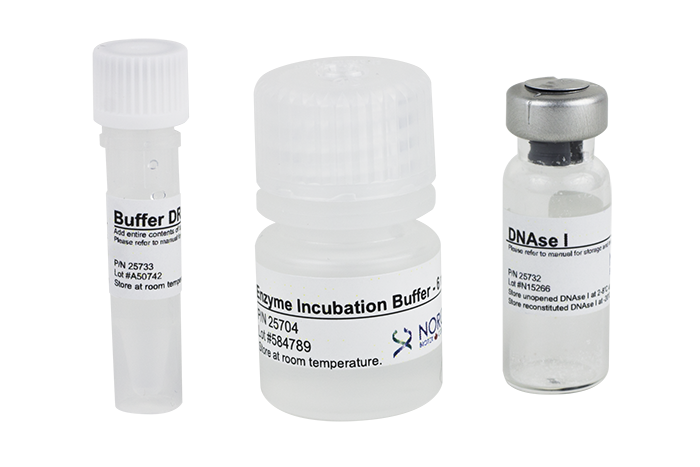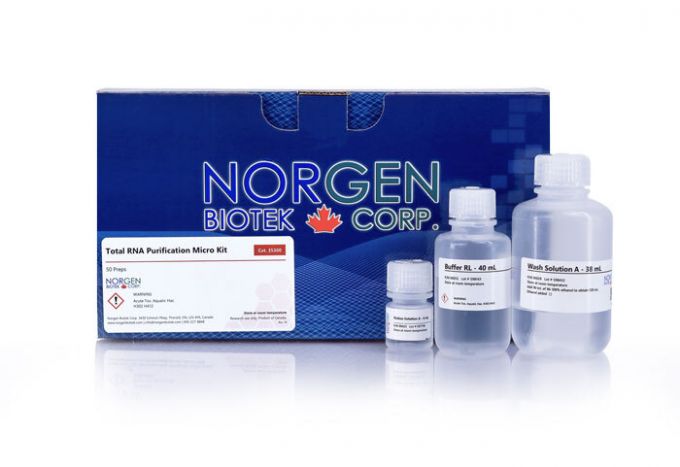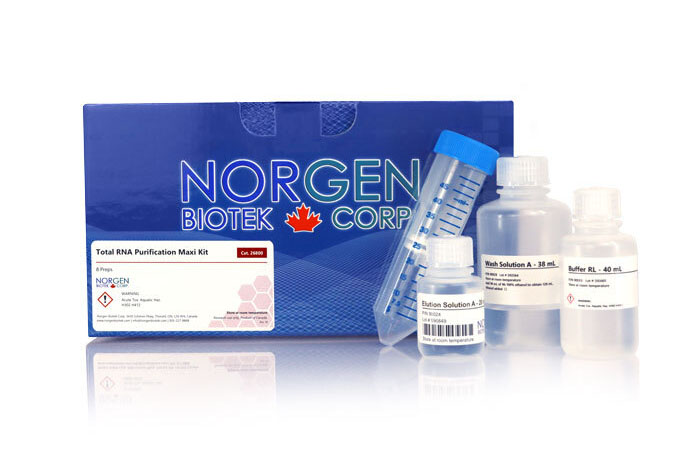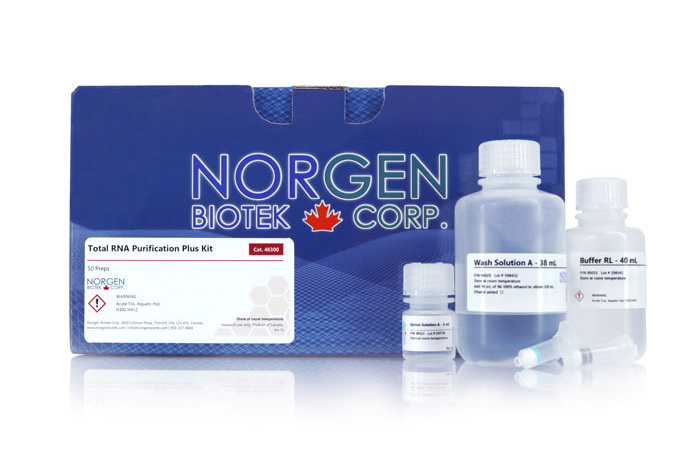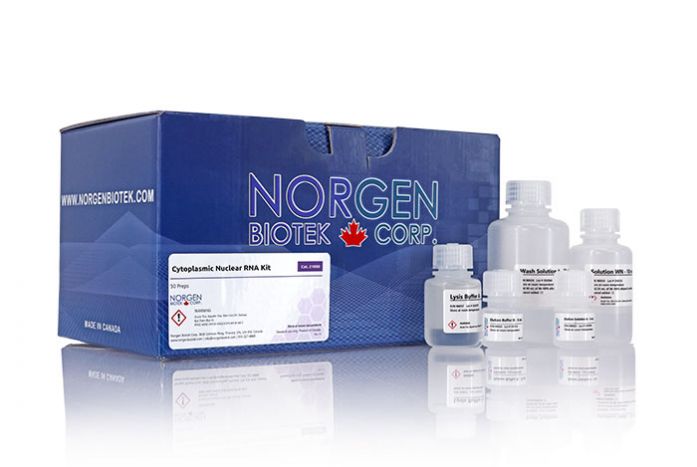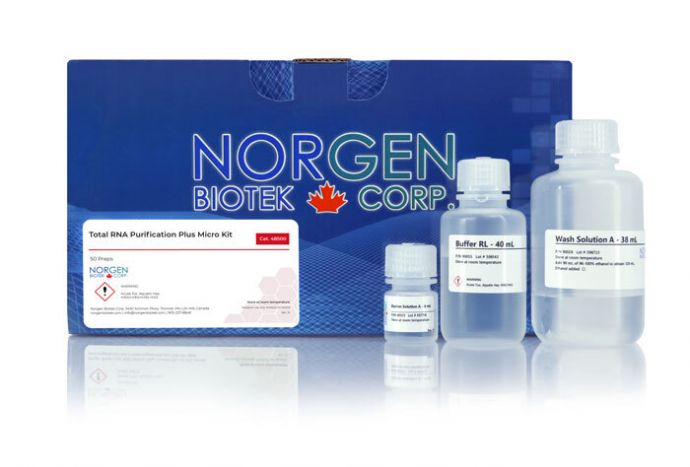Total RNA Purification Kits
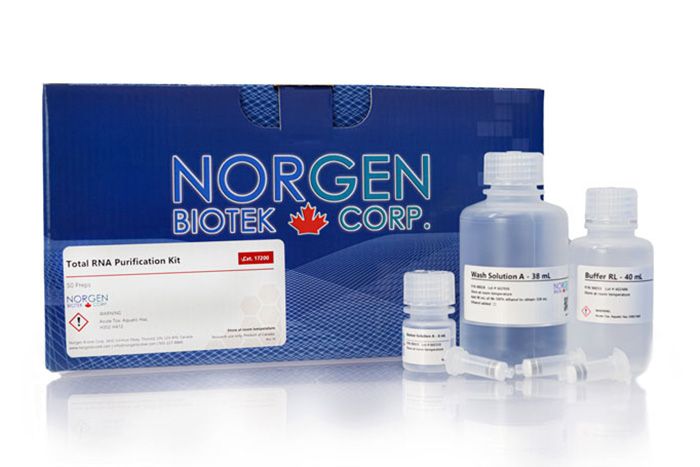
For research use only and NOT intended for in vitro diagnostics.
CE-IVDR marked diagnostic version available here
Total RNA Purification Kits
Register today to receive an exclusive 15% off* on your first order.
Features and Benefits
- Extract high quality & quantity total RNA including miRNA
- Total RNA extraction without using phenol/chloroform
- Bind & elute all RNA irrespective of size or GC content, without bias
- Very sensitive & linear down to a few cells without the need for carrier RNA
- Wide variety of specimens can be processed for RNA extraction
- Isolates significantly higher amounts of small RNA compared to competitor total RNA extraction kit
- Purified RNA is suitable for a variety of downstream applications, including Small RNA Sequencing. Find out more information on Norgen's NGS services
- Available in a variety of formats to suit your needs
- Purification is based on spin column chromatography that uses Norgen’s resin separation matrix
These kits are suitable for the isolation of total RNA from a range of samples including cells, bacteria, yeast, virus and bodily fluids including plasma/serum, blood, saliva, CSF and more. Extract high quality and purity RNA with excellent RIN values and A260/A280 suitable for downstream applications including qRT-PCR, RT-PCR, microarrays, NGS and more. These kits purify all sizes of RNA from large mRNA, lncRNA down to microRNA (miRNA) in the same fraction without the requirement of phenol. Isolate all RNA sequences at an equal rate irrespective of size. Moreover, when the RNA sequences are small (e.g. miRNA), the column binds small RNAs regardless of their GC content.
Total RNA Purification 96-Well Kit (High Throughput and High Throughput Deep Well)
This 96-well kit provides a rapid method for the high-throughput isolation and purification of total RNA in 30 minutes using vacuum manifold, plate centrifuge, or liquid handlers with vacuum capabilities. Total RNA can be isolated from a broad range of sample sources including cultured cells, tissues, blood, serum, plasma, bacteria, yeast, fungi, and viruses.
Isolate RNA after Purifying EVs and Exosomes
Ultracentrifugation, Exoquick, Filtration
| Cat. # | Name | Elution Volume | Plasma/Serum | Urine | Cell-Culture Media |
|---|---|---|---|---|---|
| 55000 | Plasma/Serum RNA Purification Mini Kit | 10 - 25 µL | 50 µL - 1 mL | 250 µL - 1 mL | 5 - 10 mL |
| 35300 | Total RNA Purification Micro Kit | 20 - 50 µL | 1 - 4 mL | 2 - 10 mL | 10 - 20 mL |
| 17200 | Total RNA Purification Kit | 50 - 100 µL | 4 - 10 mL | 11 - 30 mL | 20 - 35 mL |
Details
Supporting Data
Figure 1. High Quality of Isolated RNA with Complete Size Range. Unlike most competitors' kits, Norgen's Total RNA Purification Kit allows for the isolation of all sizes of RNA, from the very large RNA down to the microRNA, without the use of phenol. Total RNA was isolated from 1 x 109 E. coli cells using Norgen’s Total RNA Purification Kit and a competitor’s kit. Five microliters and 1 µL of the 50 µL isolated RNA was analyzed on an agarose gel (Panel A) and the Agilent® 2100 BioAnalyzer RNA Nano 6000 chip (Panel B), respectively. Note the presence of small RNA species (red square) in the samples isolated via Norgen's kit and the absence of these RNA species in the competitor RNA preparation.
Figure 2. Amplification of Both Large and Small RNAs in the Same Extraction. Norgen's Total RNA Purification Kit isolates the complete size range of RNA, including small RNAs without the use of phenol. Total RNA was isolated from 0.75 million HeLa cells using Norgen's Total RNA Purification Kit, various silica-based competitors and phenol-based TRI Reagent. RT-PCR was performed according to Shi and Chiang (2005). Fifteen microliters of the 50 µL isolated RNA were polyadenylated in a 50 µL Poly-(A)-Polymerase reaction. Four microliters of the polyadenylated RNA were used in a 20 µL reverse transcription reaction with a poly T adaptor primer. One microliter of the reverse transcription was used in a 20 µL qPCR reaction with primers against the human microRNAs (miR-19 and miR-21) and large mRNA (S15). Only the use of Norgen's Total RNA Purification Kit resulted in detection of both microRNAs and mRNA amplification products similar to Competitor 2's kit but without the use of phenol.
Figure 3. High Quality of RNA from a Diverse Range of Inputs. Norgen's Total RNA Purification Kit allows RNA isolation from a wide range of species or tissue types. Total RNA was isolated from 5 x 108 E. coli cells, 1 x 106 HeLa cells, 100 µL rat blood and 10 mg hamster kidney using Norgen's Total RNA Purification Kit. One microliter of the 50 µL isolated RNA was analyzed on the Agilent® 2100 BioAnalyzer using an RNA Nano 6000 chip. Note the integrity of RNA from all inputs with the presence of small RNA species. Norgen's Total RNA Purification Kit consistently isolates high quality RNA from various inputs that score a RIN value between 8 and 10.
Figure 4. Great Isolation Sensitivity. Norgen's Total RNA Purification Kit allows sensitive RNA extraction from as little as a single cell. Total RNA was extracted from a decreasing number of 293 HEK cells from 1 million cells down to a single cell. Five microliters of the 50 µL isolated RNA was then subjected to a 20 µL reverse transcription using oligo dT primer. Three microliters of the reverse transcription was used in a 20 µL PCR reaction with primers to detect the human beta-actin transcripts. PCR products of beta-actin were detected from as little as a single cell. M is the marker lane.
Figure 5. Linear and Sensitive Isolation of Both Large and Small RNA. Norgen’s Total RNA Purification Kit allows consistent isolation of both large and small RNA from different input amounts. Total RNA was isolated from 10 to 100,000 HeLa cells using Norgen's Total RNA Purification Kit (blue), a competitor’s silica-based kit (green) and a phenol-based RNA extraction method (red). Relative expression of miR-21 (Panel A), and S15 (Panel B) was determined by RT-qPCR of total RNA samples. In brief, one microliter of the 50 µL isolated RNA was then subjected to a 20 µL reverse transcription using miR-21 stem-loop reverse primer or oligo dT primer. Two microliters of the reverse transcription was used in a 20 µL real-time PCR reaction with primers to detect the human miR-21 (Panel A) and the S15transcripts (Panel B). The resulting threshold cycle (Ct) values were plotted against input cell number. RNA isolated using Norgen's Total RNA Purification had the best linearity (higher R2) and sensitivity (lower Ct) for both large RNA (S15) and small RNA (miR-21).
Figure 6. Effective and Consistent Detection of miRNA from Plasma. Norgen's Total RNA Purification Kit can effectively isolate miRNA from plasma. Total RNA was isolated from 50, 100 or 200 µL of rat plasma in triplicates using Norgen's Total RNA Purification Kit (blue), a competitor’s silica-based kit (green) and a phenol-based RNA extraction method (red). Stem loop RT-qPCR using primers specific to miR-21 was performed. In brief, two microliters of the 50 µL isolated RNA was then subjected to a 20 µL reverse transcription using miR-21 stem-loop reverse primer or oligo dT primer. Three microliters of the reverse transcription was used in a 20 µL real-time PCR reaction with primers to detect the human miR-21. Norgen's Total RNA Purification Kit is the only product that showed (1) consistent detection of miR-21 transcripts across all input volumes, and (2) Ct values correlated to input volume (decrease Ct with increase input).
Figure 7. Recovering Diverse miRNA Species from Plasma with Better Consistency. Norgen's Total RNA Purification Kit isolates plasma RNA that performs more consistently in downstream applications such as microarrays. Total RNA including miRNA was isolated from 100 µL of mouse plasma in duplicate using Norgen's Total RNA Purification Kit, Competitor 1's leading miRNA Kit or a phenol-based RNA extraction method. One hundred nanograms of extracted RNA from each kit was applied to an Illumina microRNA expression profiling kit. Scatter plots display better consistency (better clustering) of replicate signals from Norgen's samples. Genes with Pval < 0.01 for both replicates were in blue. The associated table suggested that Norgen's protocol recovered the same diversity of miRNA with better consistency (higher r2 value).
Figure 8. Better Diversity of miRNA Detected from Plasma. Norgen's Total RNA Purification Kit isolates miRNA from plasma with better diversity than a leading competitor. Total RNA including miRNA was isolated from 100 µL of plasma using Norgen's Total RNA Purification Kit or 625 µL of plasma using Competitor A's leading miRNA Kit, and was applied to an NCode expression profiling kit. Microarray images suggested that Norgen's Total RNA Purification Kit (left) isolates a better diversity of miRNA from smaller input amount of plasma than the competitor’s miRNA kit (right). Image courtesy of LC Sciences, Houston.
Figure 9. Better Diversity of miRNA Detected from HeLa Cells using Illumina Small RNA Next Gen Sequencing. Norgen's Total RNA Purification Kit isolates miRNA from HeLa cells with better diversity than a leading competitor. Total RNA including miRNA was isolated from 1 million HeLa cells using Norgen's Total RNA Purification Kit and Competitor Q's leading miRNA Kit, and was applied to Illumina Small RNA Next Gen Sequencing on a MiSeq sequencer. Panel A showed that Norgen’s Total RNA Purification Kit recovers a higher number of miRNAs than the competitor. In particular, the higher diversity is achieved with a faster and simpler procedure in as little as 20 minutes of RNA sample preparation time without the use of phenol. Panel B is a scatter plot of the average RPM (reads per million) of the miRNAs detected used to compare Norgen and the competitor's kit recovery of miRNA. Norgen's Total RNA Purification Kit recovered a significantly higher number of miRNAs that have higher RPM, as summarized in the graph insert as well as in Panel C.
Figure 10. Consistent Yield of High Quality RNA with Complete Size Range without the Use of Phenol. Norgen's Total RNA Purification 96-Well Kit allows for the consistent isolation of high quality RNA, with complete sizes ranging from very large RNA down to small RNA without the use of phenol. Total RNA was isolated from 0.5 mL aliquots of an overnight culture of E. coli (~5 x 108 cells/mL) using Norgen's Total RNA Purification 96-Well Kit in 16 replicates. Five microliters of the 75 µL isolated RNA were resolved on a 1.2% formaldehyde agarose gel. All 16 replicates showed both high yield and high quality. In addition, all replicates showed effective recovery of all sizes of RNA including the small RNA (arrow).
Figure 11. High Quality of RNA from a Diverse Range of Inputs. Norgen's Total RNA Purification 96-Well Kit allows for RNA isolation from a wide range of species and tissue types. Total RNA was isolated from 8 mg of brain (Lanes A), kidney (Lanes B), liver (Lanes C), lung (Lanes D) and spleen tissue (Lanes E), 7.5 x 105 HeLa (Lanes F) and CHO cells (Lanes G), and 5 x 108 bacteria (Lanes H) using Norgen's Total RNA Purification 96-Well Kit. Five microliters of the 75 µL isolated RNA were resolved on a 1.2% formaldehyde agarose gel. From observing the formaldehyde-agarose gel, it can be seen that Norgen's kit can be used to successfully isolate total RNA, including small RNA species, from a broad range of sample types.
Figure 12. Isolation of Both Large and Small RNA. Norgen's Total RNA Purification 96-Well Kit allows for consistent isolation of both large and small RNA. Total RNA was isolated from samples of 5 x 105 HeLa cells using Norgen's Total RNA Purification 96-Well Kit. Aliquots of each total RNA sample were then used in 2 different RT-qPCR reactions. Ten microliters of the 75 µL isolated RNA were subjected to a 20 µL reverse transcription using miR-21 stem-loop reverse primer or oligo dT. Three microliters of the reverse transcription were used in a 20 µL real-time PCR reaction with primers to detect the human miR-21 (Panel A) and the S15 transcripts (Panel B), respectively. Both the mRNA and microRNA were amplified in a consistent manner from all the samples, with low variability of the Ct values. Thus both types of RNA are being consistently isolated using this kit.
Figure 13. Great Isolation Sensitivity. Norgen's Total RNA Purification Kit allows for sensitive RNA extraction from even less than 10 cells. RT-qPCR was used to detect mRNA isolated from various input amounts of HeLa cells, from 100,000 down to a single cell, using Norgen's Total RNA Purification 96-Well Kit. Ten microliters of the 75 µL isolated RNA were then subjected to a 20 µL reverse transcription using oligo dT primers. Three microliters of the reverse transcription were used in a 20 µL real-time PCR reaction with primers to detect the human S15 transcripts. The resulting Ct values were plotted against the input cell number. Total RNA was isolated and detected linearly from as little as a single HeLa cell.
|
Kit Specifications
|
|
|
Maximum Binding Capacity
|
Up to 50 μg RNA
|
|
Maximum Loading Volume
|
650 μL
|
|
Size of RNA Purified
|
All sizes, including small RNA (< 200 nt)
|
|
Maximum Amount of Starting Material
|
|
| Animal Cells | 3 x 106 cells |
| Animal Tissues | 10 mg (for most tissues*) |
| Blood | 100 μL |
| Plasma/Serum | 200 μL |
| Bacteria | 1 x 109 cells |
| Yeast |
1 x 108 cells
|
| Fungi |
50 mg
|
| Plant Tissues |
50 mg
|
| Time to Complete 10 Purifications |
20 minutes
|
| Average Yield | |
| HeLa Cells (1 x 106 cells) | 15 μg |
| E. coli (1 x 109 cells) | 50 μg |
* for isolating total RNA from larger amounts of tissue, please use Norgen's Animal Tissue RNA Purification Kit (Cat# 25700)
Storage Conditions and Product Stability
All solutions should be kept tightly sealed and stored at room temperature. These kits are stable for 2 years after the date of shipment.
| Component | Cat. 17200 (50 preps) | Cat. 37500 (100 preps) | Cat. 17250 (250 preps) | Cat. 17270 (500 preps) | Cat. 24300 (192 preps) | Cat. 24370 (576 preps) | Cat. 24350 (192 preps) | Cat. 24380 (576 preps) |
|---|---|---|---|---|---|---|---|---|
| Buffer RL | 40 mL | 2 x 40 mL | 175 mL | 350 mL | 2 x 40 mL | 350 mL | 2 x 40 mL | 350 mL |
| Wash Solution A | 38 mL | 2 x 38 mL | 148 mL | 1 x 148 mL 1 x 74 mL |
2 x 38 mL | 1 x 74 mL 1 x 148 mL |
2 x 38 mL | 1 x 74 mL 1 x 148 mL |
| Elution Solution A | 6 mL | 2 x 6 mL | 30 mL | 60 mL | 2 x 20 mL | 60 mL | 2 x 20 mL | 60 mL |
| Mini Spin Columns | 50 | 100 | 250 | 500 | - | - | - | - |
| 96-Well Isolation Plate | - | - | - | - | 2 | 6 | - | - |
| 96-Well Isolation Plate (Deep Well) | - | - | - | - | - | - | 2 | 6 |
| Adhesive Tape | - | - | - | - | 4 | 12 | 4 | 12 |
| Collection Tubes | 50 | 100 | 250 | 500 | - | - | ||
| 96-Well Collection Plate | - | - | - | - | 2 | 6 | - | - |
| 96-Well Collection Plate (Deep Well) | - | - | - | - | - | - | 2 | 6 |
| Elution Tubes (1.7 mL) | 50 | 100 | 250 | 500 | - | - | ||
| 96-Well Elution Plate | - | - | - | - | 2 | 6 | - | - |
| 96-Well Elution Plate (Deep Well) | - | - | - | - | - | - | 2 | 6 |
| Product Insert | 1 | 1 | 1 | 1 | 1 | 1 | 1 | 1 |
Documentation
(37500) Total RNA Purification Kit (Spin Column) - Protocol (100 prep)
(17250) Total RNA Purification Kit (Spin Column) - Protocol (250 prep)
(17270) Total RNA Purification Kit (Spin Column) - Protocol (500 prep)
(24300) Total RNA Purification 96-Well Kit (High Throughput) - Protocol (96-well) - (2 x 96-well plates)
(24370) Total RNA Purification 96-Well Kit (High Throughput) - Protocol (96-well) - (6 x 96-well plates)
(24350) Total RNA Purification 96-Well Kit (High Throughput Deep Well) - Protocol (Deep Well) - (2 x 96-well plates)
(24380) Total RNA Purification 96-Well Kit (High Throughput Deep Well) - Protocol (Deep Well) - (6 x 96-well plates)
Total RNA Purification Kit - Supplementary Protocol for Exosomal RNA Purification from Exosomes Already Purified
Supplementary Protocol for Total RNA Isolation from Staphylococcus aureus-Related Bacteria and Hard-to-Lyse Bacterial Species
Isolation of RNA from Norgen’s Swab Collection and Total Nucleic Acid Preservation System
Supplementary Protocol - Norgen's Saliva RNA Collection and Preservation Devices
Supplementary Protocol for Isolating Viral RNA from Swab Samples
Isolation of True Total RNA using the Tempus™ Blood RNA Tube and Norgen’s Total RNA Purification Kit
Effect of RNA Isolation Method on microRNA Quantity and Quality in Plasma: A Comparative Study
Revised Guidelines for RNA Quality Assessment for Diverse Biological Sample Input
Total RNA/DNA Purification and Detection from Blood Preserved on a Neoteryx™ Mitra Microsampling Device
Effect of microRNA GC Content on RNA Purification Efficiency
37500 - Total RNA Purification Kit (Spin Column 100 Prep) - SDS
17250 - Total RNA Purification Kit (Spin Column 250 Prep) - SDS
17270 - Total RNA Purification Kit (Spin Column 500 Prep) - SDS
24300 - Total RNA Purification Kit Dx (2x 96 Well Plates) - SDS
24350 - Total RNA Purification Kit Dx (2x 96 Deep Well Plates) - SDS
24370 - Total RNA Purification Kit Dx (6x 96 Well Plates) - SDS
24380 - Total RNA Purification Kit Dx (6x 96 Deep Well Plates) - SDS
Substrate Specificity of Taq Polymerase - ASCB 2007
Genomic Profiling of Hepatitis B Virus and Hepatitis C Virus From 1 mL of Urine - ASM 2007
Silicon Carbide As A Novel RNA Affinity Medium With Improved Sensitivity and Size Diversity - microRNA 2008
Effect of RNA Isolation Methods On microRNA Quantity and Quality In Plasma - TriCon 2013
Revised Guidelines For RNA Quality Assessment For Diverse Biological Sample Input - ASCB 2008
Variation Between The Purification Efficiency of microRNA With Different Gc Content - TriCon 2013
The Impact of Sample Preparation On Microrna Quality and Diversity For Downstream Applications - microRNA 2009
Rapid and qPCR ready DNA isolation from environmental and human bodily fluid samples using Magnetic bead system
Videos
Total RNA Purification Tutorial (Cat. 17200)
FAQs
Spin Column, High Throughput, High Throughput Deep Well
Poor RNA recovery could be due to one or more of the following:
- Incomplete lysis of cells or tissue. Ensure that the appropriate amount of Buffer RL was used for the amount of cells or tissue.
- Column has become clogged. Do not exceed the recommended amounts of starting materials. The amount of starting material may need to be decreased if the column shows clogging below the recommended levels. See FAQ related to “Clogged Columns/wells” below.
- An alternative elution solution was used. It is recommended that the Elution Solution A supplied with this kit be used for maximum RNA recovery.
- Ethanol was not added to the lysate. Ensure that the appropriate amount of ethanol is added to the lysate before binding to the column.
- Ethanol was not added to the Wash Solution A. Ensure that 90 mL of 96-100% ethanol is added to the supplied Wash Solution A prior to use.
- Low RNA content in cells or tissues used. Different tissues and cells have different RNA contents, and thus the expected yield of RNA will vary greatly from these different sources. Please check literature to determine the expected RNA content of your starting material.
- Cell Culture: Cell monolayer was not washed with PBS. Ensure that the cell monolayer is washed with the appropriate amount of PBS in order to remove residual media from cells.
- Yeast: Lyticase was not added to the Resuspension Buffer. Ensure that the appropriate amount of lyticase is added when making the Resuspension Buffer.
- Bacteria and Yeast: All traces of media not removed. Ensure that all media is removed prior to the addition of the Buffer RL through aspiration.
Column/well clogging can result from one or combination of the following factors:
- Insufficient solubilization of cells or tissues. Ensure that the appropriate amount of Buffer RL was used for the amount of cells or tissue.
- Maximum number of cells or amount of tissue exceeds kit specifications. Refer to specifications to determine if the amount of starting material falls within kit specifications.
- High amounts of genomic DNA present in sample. The lysate may be passed through a 25 gauge needle attached to a syringe 5-10 times in order to shear the genomic DNA prior to loading onto the column.
- Centrifuge temperature is too low. Ensure that the centrifuge remains at room temperature throughout the procedure. Temperatures below 15°C may cause precipitates to form that can cause the columns to clog.
RNA can be degraded due to the following factors:
- RNase contamination. RNases may be introduced during the use of the kit. Ensure proper procedures are followed when working with RNA. Please refer to “Working with RNA” at the beginning of this user guide.
- Procedure not performed quickly enough. In order to maintain the integrity of the RNA, it is important that the procedure be performed quickly. This is especially important for the Cell Lysate Preparation Step in the Animal Tissue protocol, since the RNA in animal tissues is not protected after harvesting until it is disrupted and homogenized.
- Improper storage of the purified RNA. For short term storage RNA samples may be stored at –20°C for a few days. It is recommended that samples be stored at –70°C for longer term storage.
- Frozen tissues or cell pellets were allowed to thaw prior to RNA isolation. Do not allow frozen tissues to thaw prior to grinding with the mortar and pestle in order to ensure that the integrity of the RNA is not compromised.
- Starting material may have a high RNase content. For starting materials with high RNase content, it is recommended that β-mercaptoethanol be added to the Buffer RL.
- Lysozyme or lyticase used may not be RNase-free. Ensure that the lysozyme and lyticase being used with this kit is RNase-free, in order to prevent possible problems with RNA degradation.
If the RNA does not perform well in downstream applications, it may be due to one or more of the following:
- RNA was not washed 3 times with the provided Wash Solution A. Traces of salt from the binding step may remain in the sample if the column is not washed 3 times with Wash Solution A. Salt may interfere with downstream applications, and thus must be washed from the column.
- Ethanol carryover. Ensure that the dry spin under the Column Wash Procedure is performed, in order to remove traces of ethanol prior to elution. Ethanol is known to interfere with many downstream applications.
The contamination with genomic DNA may be due to large amount of starting material used. Perform RNase-free DNase I digestion on the RNA sample after elution to remove genomic DNA contamination. It is recommended that Norgen’s RNase-Free DNase I Kit (Product # 25710) be used for this step.
Yes, the Total RNA purification kits can be used to purify RNA from samples like buffy coats and isolated PBMCs. For blood leukocyte samples, you can use a specialized product - Leukocyte RNA purification kit.
Yes, Total RNA purification kits can be used with samples stored in RNA protective agents like RNAlater. Norgen Biotek also provides a similar RNA preserve solution (Cat. 17260).
Yes, you can use Total RNA purification kits to purify RNA from insect samples. Please contact our Tech support team at support@norgenbiotek.com and ask for reference publications.
Yes, lysates prepared in buffer RL can be frozen at -80°C, and the remaining protocol can be performed at a later date.
Yes, you can use Norgen's Total RNA purification kits with the aqueous phase from samples prepared in TRIzol. Please contact our Tech Support team at support@norgenbiotek.com if you have any questions regarding the protocol.
Yes, Norgen Total RNA purification kits are compatible with tissue samples stored in OCT compound. Please contact our Tech Support team at support@norgenbiotek.com and ask for reference publications.
Citations
| Title | Analysis of Plasma MicroRNA Expression Profiles in Male Textile Workers with Noise-induced Hearing Loss |
| Citation | Hearing Research 2023. |
| Authors | Lu Dinga, Jing Liub, Huan-Xi Shenc, Li-Ping Panb, Qing-Dong Liud, Heng-Dong Zhange, Lei Hane, Li-Guo Shuaif, En-Min Dingb, Qiu-Ni Zhaod, Bo-Shen Wangg, Bao-Li Zhue, , |
| Title | Androgen Mediated Regulation of Endoplasmic Reticulum-Associated Degradation and its Effects on Prostate Cancer |
| Citation | Scientific Reports 2023. |
| Authors | Erzurumlu, Y., & Ballar, P. |
| Title | Anti-inflammatory and antioxidant activities of ginsenosides and ginseng root extract to counteract obesity |
| Citation | European Food Research and Technology 2023. |
| Authors | Simone Angeloni, Oliviero Marinelli, Cristina Aguzzi, Massimo Nabissi, Laura Bordoni, Irene Petracci, Rosita Gabbianelli, Valentina Cecarini, Mauro Angeletti, Anna Maria Eleuteri, Huimin Liu, Giovanni Caprioli & Gianni Sagratini |
| Title | Anti-inflammatory effect of ubiquinol-10 on young and senescent endothelial cella via miR-146a modulation |
| Citation | Free Radical Biology and Medicine 2023. |
| Authors | F. Olivieri, R. Lazzarini, L. Babini, F. Prattichizzo, M.R. Rippo, L. Tiano, S. Di Nuzzo, L. Graciotti, R. Festa, F. Bruge, P. Orlando, S. Silvestri, M. Capri, L. Pamla, M. Magnani, C. Franceschi, G.P Littarri, A.D Procopio |
| Title | Anti-proliferation properties of Egyptian medicinal herbs Moringa oleifera and Vinca rosacrude extracts against Human colorectal cells |
| Citation | Egyptian Journal of Chemistry 2023. |
| Authors | Mohga Magdy Said, Amr Nassrallah and Ahmed M. Aboul-Enein |
| Title | APOBEC3A cytidine deaminase induces RNA editing in monocytes and macrophages |
| Citation | Nature Communications 2023. |
| Authors | S Sharma, SK Patnaik, RT Taggart, ED Kannisto, SM Enriquez, P Gollnick, BE Baysal |
| Title | Artificial membrane-binding proteins stimulate oxygenation of stem cells during engineering of large cartilage tissue |
| Citation | Nature Communications 2023. |
| Authors | JPK Armstrong, R Shakur, JP Horne, SC Dickenson, CT Armstrong, K Lau, J Kadiwala, R Lower, A Seddon, S Mann, JLR Anderson, AW Perriman, AP Hollander |
| Title | Assessing the functional potential of conditioned media derived from amniotic epithelial stem cells engineered on 3D biomimetic scaffolds: An in vitro model for tendon regeneration |
| Citation | Materials Today Bio 2023. |
| Authors | Valentina Russo a 1, Giuseppe Prencipe a 1, Annunziata Mauro a, Mohammad El Khatib a, Arlette A. Haidar-Montes a, Nico Cambise a b, Maura Turriani a, Johannes Stöckl c, Peter Steinberger c, Loreto Lancia d, Matthias Schnabelrauch e, Paolo Berardinelli a, Barbara Barboni a |
| Title | Assessment of promoters and a selectable marker for development of strawberry intragenic vectors |
| Citation | Plant Cell, Tissue and Organ Culture (PCTOC) 2023. |
| Authors | Carvalho, R. F., & Folta, K. M |
| Title | Assessment of the biological invasion risks associated with a massive outdoor cultivation of the green alga, Pseudochoricystis ellipsoidea |
| Citation | Algal Research 2023. |
| Authors | I Matsuwaki, S Harayama, M Kato |


